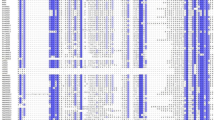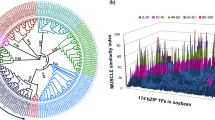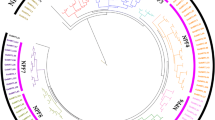Abstract
Background
Strigolactones (SLs) are newly identified hormones and their biosynthesis is stimulated under phosphate deprivation and accomplished by the action of several enzymes, including the beta-carotene isomerase DWARF27 (D27). Expression of D27 is well renowned to respond to phosphate insufficiency. However, the identification and functional analysis of the carotenoid isomerase D27 genes are not elucidated in soybean.
Methods and results
A total of six D27 genes were identified in the soybean genome and designated on the basis of chromosomal localization. According to the findings, these genes were irregularly distributed on chromosomes, and segmental repetition led to the expansion of the soybean GmD27 gene family. Based on a neighbor-joining phylogenetic tree, the predicted D27 proteins of soybean were divided into three clades. Based on RNA seq data analysis, GmD27 genes were differently expressed in various tissues but GmD27c was the highest. Therefore, GmD27c was chosen for the additional functional study due to its rather obvious transcription in nodulation and roots. RT-qPCR results showed that GmD27c was highly expressed in different nodule stages and in response to rhizobia infection. Functional characterization of GmD27c revealed that overexpression of GmD27c led to higher nodule number, while GmD27c knockdown caused fewer nodules compared to GUS control. Furthermore, GmD27c overexpressed and knockdown lines oppositely regulated the expression of numerous nodulation genes, which are vital for the development of nodules.
Conclusion
This study not only discovered that SL biosynthesis and signaling pathway genes are conserved, but it also revealed that SL biosynthesis gene GmD27c and legume rhizobia have close interactions in controlling plant nodule number.







Similar content being viewed by others
References
Xie X, Yoneyama K, Yoneyama K (2010) The strigolactone story. Annu Rev Phytopathol 48:93–117. https://doi.org/10.1146/annurev-phyto-073009-114453
Akiyama K, Matsuzaki K, Hayashi H (2005) Plant sesquiterpenes induce hyphal branching in arbuscular mycorrhizal fungi. Nature 435:824–827. https://doi.org/10.1038/nature03608
Bouwmeester HJ, Matusova R, Zhongkui S, Beale MH (2003) Secondary metabolite signalling in host-parasitic plant interactions. Curr Opin Plant Biol 6:358–364
Waldie T, McCulloch H, Leyser O (2014) Strigolactones and the control of plant development: lessons from shoot branching. Plant J 79:607–622. https://doi.org/10.1111/tpj.12488
Liu W, Kohlen W, Lillo A et al (2011) Strigolactone biosynthesis in Medicago truncatula and rice requires the symbiotic GRAS-type transcription factors NSP1 and NSP2. Plant Cell 23:3853–3865. https://doi.org/10.1105/tpc.111.089771
Liu J, Novero M, Charnikhova T et al (2013) Carotenoid cleavage dioxygenase 7 modulates plant growth, reproduction, senescence, and determinate nodulation in the model legume Lotus japonicus. J Exp Bot 64:1967–1981. https://doi.org/10.1093/jxb/ert056
Foo E, Yoneyama K, Hugill CJ et al (2013) Strigolactones and the regulation of pea symbioses in response to nitrate and phosphate deficiency. Mol Plant 6:76–87. https://doi.org/10.1093/mp/sss115
Umehara M, Hanada A, Yoshida S et al (2008) Inhibition of shoot branching by new terpenoid plant hormones. Nature 455:195–200. https://doi.org/10.1038/nature07272
Gomez-Roldan V, Fermas S, Brewer PB et al (2008) Strigolactone inhibition of shoot branching. Nature 455:189–194. https://doi.org/10.1038/nature07271
Beveridge CA, Symons GM, Turnbull CG (2000) Auxin inhibition of decapitation-induced branching is dependent on graft-transmissible signals regulated by genes Rms1 and Rms2. Plant Physiol 123:689–698. https://doi.org/10.1104/pp.123.2.689
Booker J et al (2005) MAX1 encodes a cytochrome P450 family member that acts downstream of MAX3/4 to produce a carotenoid-derived branch-inhibiting hormone. Dev Cell 8:443–449
Simons JL, Napoli CA, Janssen BJ et al (2006) Analysis of the decreased apical dominance genes of petunia in the control of axillary branching. Plant Physiol 143:697–706. https://doi.org/10.1104/pp.106.087957
Arite T, Iwata H, Ohshima K et al (2007) DWARF10, an RMS1/MAX4/DAD1 ortholog, controls lateral bud outgrowth in rice. Plant J 51:1019–1029. https://doi.org/10.1111/j.1365-313X.2007.03210.x
Lin H, Wang R, Qian Q et al (2009) DWARF27, an iron-containing protein required for the biosynthesis of strigolactones, regulates rice tiller bud outgrowth. Plant Cell 21:1512–1525. https://doi.org/10.1105/tpc.109.065987
Matusova R (2005) The strigolactone germination stimulants of the plant-parasitic striga and Orobanche spp. are derived from the carotenoid pathway. Plant Physiol 139:920–934. https://doi.org/10.1104/pp.105.061382
Alder A, Jamil M, Marzorati M et al (2012) The path from-carotene to carlactone, a strigolactone-like plant hormone. Science 335:1348–1351. https://doi.org/10.1126/science.1218094
Abe S, Sado A, Tanaka K et al (2014) Carlactone is converted to carlactonoic acid by MAX1 in Arabidopsis and its methyl ester can directly interact with AtD14 in vitro. Proc Natl Acad Sci 111:18084–18089. https://doi.org/10.1073/pnas.1410801111
Breakspear A, Liu C, Roy S et al (2014) The root hair “infectome” of Medicago truncatula uncovers changes in cell cycle genes and reveals a requirement for Auxin signaling in rhizobial infection. Plant Cell 26:4680–4701. https://doi.org/10.1105/tpc.114.133496
Arite T, Umehara M, Ishikawa S et al (2009) D14, a strigolactone-Insensitive mutant of rice, shows an accelerated outgrowth of tillers. Plant Cell Physiol 50:1416–1424. https://doi.org/10.1093/pcp/pcp091
de Saint GA, Clavé G, Badet-Denisot M-A et al (2016) An histidine covalent receptor and butenolide complex mediates strigolactone perception. Nat Chem Biol 12:787–794. https://doi.org/10.1038/nchembio.2147
Hamiaux C, Drummond RSM, Janssen BJ et al (2012) DAD2 is an α/β hydrolase likely to be involved in the perception of the plant branching hormone, strigolactone. Curr Biol 22:2032–2036
Stirnberg P, Furner IJ, Ottoline Leyser HM (2007) MAX2 participates in an SCF complex which acts locally at the node to suppress shoot branching. Plant J 50:80–94. https://doi.org/10.1111/j.1365-313X.2007.03032.x
Yao R, Ming Z, Yan L et al (2016) DWARF14 is a non-canonical hormone receptor for strigolactone. Nature 536:469–473. https://doi.org/10.1038/nature19073
Zhao J, Wang T, Wang M et al (2014) DWARF3 participates in an SCF complex and associates with DWARF14 to suppress rice shoot branching. Plant Cell Physiol 55:1096–1109. https://doi.org/10.1093/pcp/pcu045
Lv AL, Li XJ, Li CJ et al (2019) Cloning and expression analysis of the ScD53 gene from sugarcane. Sugar Tech 21:898–908. https://doi.org/10.1007/s12355-019-00730-z
Kaló P, Gleason C, Edwards A et al (2005) Nodulation signaling in legumes requires NSP2, a member of the GRAS family of transcriptional regulators. Science 308:1786–1789. https://doi.org/10.1126/science.1110951
van Zeijl A, Liu W, Xiao TT et al (2015) The strigolactone biosynthesis gene DWARF27 is co-opted in rhizobium symbiosis. BMC Plant Biol 15:260. https://doi.org/10.1186/s12870-015-0651-x
Foo E, Davies NW (2011) Strigolactones promote nodulation in pea. Planta 234:1073–1081. https://doi.org/10.1007/s00425-011-1516-7
Oldroyd GED (2013) Speak, friend, and enter: signalling systems that promote beneficial symbiotic associations in plants. Nat Rev Microbiol 11:252–263. https://doi.org/10.1038/nrmicro2990
McAdam EL, Hugill C, Fort S et al (2017) Determining the site of action of strigolactones during nodulation. Plant Physiol. https://doi.org/10.1104/pp.17.00741
Ahmad MZ, Rehman N, ur, Yu S et al (2020) GmMAX2-D14 and -KAI interaction-mediated SL and KAR signaling play essential roles in soybean root nodulation. Plant J 101:334–351. https://doi.org/10.1111/tpj.14545
Rehman N, ur, Ali M, Ahmad MZ et al (2018) Strigolactones promote rhizobia interaction and increase nodulation in soybean (Glycine max). Microb Pathog 114:420–430. https://doi.org/10.1016/j.micpath.2017.11.049
Finn RD, Coggill P, Eberhardt RY et al (2016) The Pfam protein families database: towards a more sustainable future. Nucleic Acids Res 44:D279–D285. https://doi.org/10.1093/nar/gkv1344
Letunic I, Doerks T, Bork P (2015) SMART: recent updates, new developments and status in 2015. Nucleic Acids Res 43:D257–D260. https://doi.org/10.1093/nar/gku949
Lu S, Wang J, Chitsaz F et al (2020) CDD/SPARCLE: the conserved domain database in 2020. Nucleic Acids Res 48:D265–D268. https://doi.org/10.1093/nar/gkz991
Stothard P (2000) Internet on-ramp internet on-ramp. Biotechniques 28:1102–1104
Chen C, Xia R, Chen H, He Y (2018) TBtools, a toolkit for biologists integrating various HTS-data handling tools with a user-friendly interface. TBtools, a Toolkit Biol Integr Var HTS-data Handl tools with a user-friendly interface. https://doi.org/10.1101/289660
Larkin MA, Blackshields G, Brown NP et al (2007) Clustal W and Clustal X version 2.0. Bioinformatics 23:2947–2948. https://doi.org/10.1093/bioinformatics/btm404
Kumar S, Stecher G, Tamura K (2016) MEGA7: molecular evolutionary genetics analysis version 7.0 for bigger datasets. Mol Biol Evol 33:1870–1874. https://doi.org/10.1093/molbev/msw054
Hu B, Jin J, Guo AY et al (2015) GSDS 2.0: an upgraded gene feature visualization server. Bioinformatics 31:1296–1297. https://doi.org/10.1093/bioinformatics/btu817
Bailey TL, Johnson J, Grant CE, Noble WS (2015) The MEME suite. Nucleic Acids Res 43:W39–W49. https://doi.org/10.1093/nar/gkv416
Chen C, Chen H, Zhang Y et al (2020) TBtools: an integrative toolkit developed for interactive analyses of big biological data. Mol Plant 13:1194–1202. https://doi.org/10.1016/j.molp.2020.06.009
Lescot M, Déhais P, Thijs G et al (2002) PlantCARE, a database of plant cis-acting regulatory elements and a portal to tools for in silico analysis of promoter sequences. Nucleic Acids Res 30:325–327. https://doi.org/10.1093/nar/30.1.325
Higo K, Ugawa Y, Iwamoto M, Korenaga T (1999) Plant cis-acting regulatory DNA elements (PLACE) database: 1999. Nucleic Acids Res 27:297–300. https://doi.org/10.1093/nar/27.1.297
Severin AJ, Woody JL, Bolon YT et al (2010) RNA-Seq atlas of glycine max: a guide to the soybean transcriptome. BMC Plant Biol. https://doi.org/10.1186/1471-2229-10-160
Waters MT, Brewer PB, Bussell JD et al (2012) The arabidopsis ortholog of rice DWARF27 acts upstream of MAX1 in the control of plant development by strigolactones. Plant Physiol 159:1073–1085. https://doi.org/10.1104/pp.112.196253
Akiyama K, Ogasawara S, Ito S, Hayashi H (2010) Structural requirements of strigolactones for hyphal branching in AM fungi. Plant Cell Physiol 51:1104–1117. https://doi.org/10.1093/pcp/pcq058
Soto MJ, Fernández-Aparicio M, Castellanos-Morales V et al (2010) First indications for the involvement of strigolactones on nodule formation in alfalfa (Medicago sativa). Soil Biol Biochem 42:383–385. https://doi.org/10.1016/j.soilbio.2009.11.007
Rehman NU, Li X, Zeng P et al (2021) Harmony but not uniformity: role of strigolactone in plants. Biomolecules 11:1616
Yoneyama K, Xie X, Sekimoto H et al (2008) Strigolactones, host recognition signals for root parasitic plants and arbuscular mycorrhizal fungi, from Fabaceae plants. New Phytol 179:484–494. https://doi.org/10.1111/j.1469-8137.2008.02462.x
Kohlen W, Charnikhova T, Liu Q et al (2011) Strigolactones are transported through the xylem and play a key role in shoot architectural response to phosphate deficiency in nonarbuscular mycorrhizal host arabidopsis. Plant Physiol 155:974–987. https://doi.org/10.1104/pp.110.164640
Foo E (2013) Auxin influences strigolactones in pea mycorrhizal symbiosis. J Plant Physiol 170:523–528. https://doi.org/10.1016/j.jplph.2012.11.002
Oldroyd GE, Engstrom EM, Long SR (2001) Ethylene inhibits the Nod factor signal transduction pathway of Medicago truncatula. Plant Cell 13:1835–1849. https://doi.org/10.1105/TPC.010193
Funding
This work was supported by the International Foundation for Science, Sweden (Grant I-1-C-6481-1).
Author information
Authors and Affiliations
Contributions
NR and FUK planned and designed the research; NR, FA and MI performed experiments and analyzed data; MI, IA, IU, and MR. conducted bioinformatics analyses; NR, FUKwrote the manuscript. All authors approved the final manuscript.
Corresponding author
Ethics declarations
Conflict of interest
The authors declare no conflict of interest.
Ethical approval
This article does not contain any studies with human participants or animals performed by any of the authors.
Additional information
Publisher's Note
Springer Nature remains neutral with regard to jurisdictional claims in published maps and institutional affiliations.
Supplementary Information
Below is the link to the electronic supplementary material.
Rights and permissions
About this article
Cite this article
Rehman, N., Abbas, F., Imran, M. et al. Genome wide analysis of DWARF27 genes in soybean and functional characterization of GmD27c reveals eminent role of strigolactones in rhizobia interaction and nodulation in Glycine max. Mol Biol Rep 49, 5405–5417 (2022). https://doi.org/10.1007/s11033-022-07127-4
Received:
Accepted:
Published:
Issue Date:
DOI: https://doi.org/10.1007/s11033-022-07127-4




